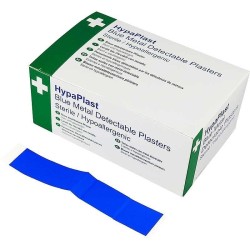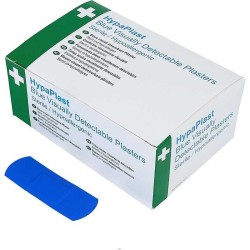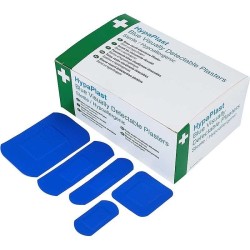Blue Visual First Aid Plasters
There are 3 products.
Active filters
About Blue Visual First Aid Plasters
Visually Detectable Wound Protection for Food Environments
Blue visual first aid plasters provide highly visible wound protection specifically designed for food handling environments through distinctive blue colouring, serving catering, food preparation, and food service contexts throughout England, Scotland, Wales, and Northern Ireland. These specialist food industry products utilise bright blue colouring rarely found in food products, enabling visual detection if plasters are lost whilst supporting HACCP compliance and food safety management. Food handling organisations rely on blue visual plasters for food handler wound protection meeting hygiene requirements, visual identification through distinctive colouring, HACCP-compliant first aid provision, cost-effective food safety compliance, and contamination prevention. Modern blue visual plasters incorporate features including bright blue colouring easily visible against food products, strong waterproof adhesion withstanding frequent hand washing, varied sizes accommodating different wounds, appropriate materials for food industry use, and cost-effective provision. The provision of blue visual plasters demonstrates commitment to food hygiene, supports regulatory compliance, enables professional food service wound management, and fulfils food safety requirements across food handling environments throughout professional contexts.
The implementation of blue visual plasters directly supports food hygiene compliance, contamination prevention, and demonstration of professional food safety management. Food handling environments require appropriate wound covering preventing contamination whilst enabling visual detection if lost. Blue visual plasters address these requirements by providing highly visible wound protection through distinctive blue colouring absent from food products, supporting visual inspection and detection procedures, enabling HACCP-compliant first aid provision, demonstrating professional food hygiene commitment, and preventing contamination through appropriate wound covering. Food industry applications include catering environment wound care, food preparation hygiene compliance, food service worker protection, restaurant and café first aid provision, and HACCP system integration. Food handling organisations benefit from blue visual plasters through cost-effective food hygiene compliance, visual detectability supporting contamination prevention, demonstrated professional standards, and comprehensive food safety management. Modern blue visual plasters incorporate features such as enhanced visibility, waterproof construction, and varied formats throughout England, Scotland, Wales, and Northern Ireland.
Selecting and implementing blue visual plasters requires food hygiene assessment, appropriate specification, and integration with food safety protocols across food handling organisations throughout the UK. Food safety and catering managers should evaluate wound protection requirements within food preparation areas, assess visual detection procedures, review HACCP plans incorporating plaster protocols, and calculate adequate stock levels. Product selection should prioritise distinctive blue colouring providing maximum visibility, strong waterproof adhesion suitable for frequent hand washing, varied sizes accommodating different wounds, appropriate materials for food industry use, and adequate quantities ensuring exclusive use in food handling areas. Implementation protocols must encompass policies requiring only blue plasters in food areas, staff training on appropriate use, integration with HACCP procedures, clear signage, and documented supply management. Quality assurance measures should include periodic audits ensuring compliance, usage monitoring, incident recording when plasters are lost requiring area inspection, and HACCP verification. Modern blue visual plaster management integrates with food hygiene systems. Organisations should establish protocols including designated plaster locations in food areas, lost plaster procedures requiring inspection, documentation, and staff education emphasising exclusive blue plaster use and immediate reporting if lost. Storage must separate blue plaster stocks from standard plasters preventing accidental non-blue plaster use in food areas. By implementing blue visual plasters alongside professional food hygiene protocols, food handling organisations throughout England, Scotland, Wales, and Northern Ireland demonstrate commitment to food safety compliance, HACCP requirements, contamination prevention, and professional hygiene management supporting consumer protection across all food preparation and handling environments.



